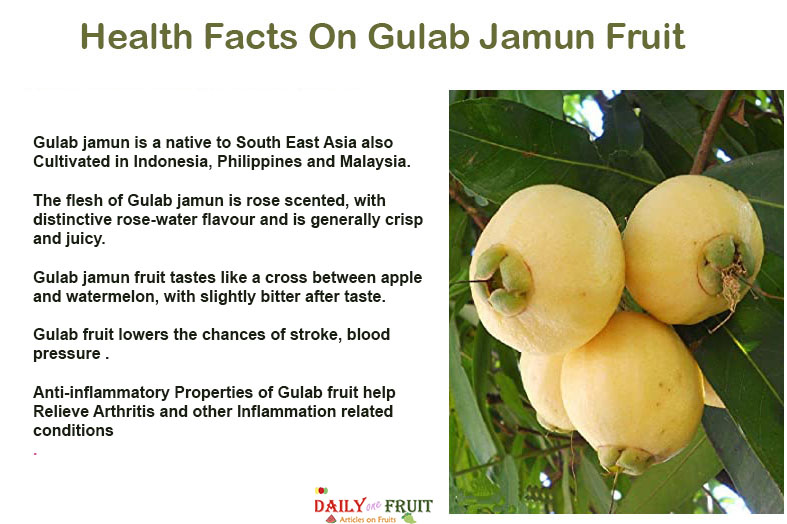
Health Facts On Gulab Jamun Fruit
The Gulab jamun Fruit Scientifically called as ” Syzygium jambos “.
Origin Of Gulab jamun
“Syzygium jambos” is a species of rose apple and Myrtaceae (myrtle) family.
Gulab jamun is a native to South East Asia but is naturalized in India, especially in South India. It also Cultivated in Indonesia, Philippines and Malaysia.
Other Names Of Gulab jamun
Rose apple, Malay apple, jambu, champakka ,pomarrosa, Jambola, Paneer fruit, Watery Rose Apple, ಪನ್ನೇರಳೆ, Guljamun, madhura nelli, Malabar Plum, Panineer Champakka, Mountain Apple ,champoo, chom pu,chom-phu
|
Appearance Of Gulab jamun
o The Gulab jamun is a drupe, up to 4-5 cm long, nearly round, oval, or slightly pear-shaped, and is capped with a prominent, green, tough calyx and style.
o The skin of Gulab jamun is smooth, thin, green at first, then pale yellow or whitish, sometimes pinkish, and covers a crisp, mealy, dry to juicy layer of yellowish flesh, that is sweet with a distinct scent of rose.
o Each Gulab jamun contains in its hollow centre one to four brown, rough-coated, medium-hard, polyembryonic, more or less rounded seeds, 1-1.5 cm in diameter.
Taste Of Gulab jamun
The flesh of Gulab jamun is rose scented, with distinctive rose-water flavour and is generally crisp and juicy.
Gulab jamun fruit tastes like a cross between apple and watermelon, with a very mild rose scent and a slightly bitter after taste.
Varieties Of Gulab jamun
Thailand cultivated variety bears a pale green fruit.
Malaysian varieties generally have red skins.
In many regions the fruit is a shade of pale yellow, often with a slight blush.
Nutritional value Of Gulab jamun
Per 100g (3.5 oz)
• Energy : 105kj (25kcal)
• Moisture : 89.1g
• Fibre : 1.9g
• Carbohydrates : 5.7g
• Fat : 0.3g
• Ash : 0.44g
• Protein : 0.6g
• Vitamin – A : 235mg IU
• Thiamine (B1) : 0.02mg
• Riboflavin (B2) : 0.03mg
• Niacin (B3) : 0.8mg
• Vitamin – C : 22.3mg
• Calcium : 29mg
• Iron : 0.07mg
• Magnesium : 5mg
• Manganese : 0.029mg
• Phosphorous : 8mg
• Potassium : 123mg
• Zinc : 0.06mg
• Sulphur : 13mg
• Copper : 0.01mg
• Sodium : 34.1mg
Health Facts On Gulab Jamun Fruit
Promotes Healthy Skin: Gulab jamun fruit contains vitamins and minerals. Such as Zinc helps the body’s natural oils be produced, which results in softer skin. The antioxidant like vitamin A and C provide good radiant for skin. Gulab jamun improves skin suppleness and reduces wrinkles and maintain youthful skin.
Keeps Healthy Hair: Gulab jamun Fruit contain essential mineral such as Iron, zinc, Vitamin A and C that serves as a conduit for oxygen to reach the scalp and hair follicles. A deficit may result in dull, brittle hair.Vitamin A present in Gulab jamun helps the skin glands produce sebum, an oily fluid that hydrates the scalp and keeps hair healthy.
Boosts Immunity: Antimicrobial and Anti-fungal effects of Gulab jamun Fruit is a good immune booster protects against microbial infections and vitamin A ,iron and calcium in the fruit enhance the body to stay strong and healthy protecting against various infectious diseases.
Enhances Eye Sight: Gulab jamun fruit have high quantities of zeaxanthin and lutein, beta-carotenoids that protect our eyes against age-related macular degeneration.
Fortifies Bone Health: Jambola fruit is notably high in essential minerals — such as calcium, magnesium and potassium — that promote bone strength lowers the occurrence of developing bone diseases such as osteoporosis. Likewise, these super fruits contain anti-inflammatory properties that help relieve arthritis and other inflammation-related conditions.
Manages Heart Health: The presence of Vitamin C, high potassium and low sodium content in Jambola fruit lowers the chances of stroke, blood pressure and health ailments such as inflammation, oxidative damage, cardiac health, atherosclerosis, and endothelial health.
Uplifts Good Cholesterol: Jambola fruit is the source of Niacin which is used to add cholesterol. The studies shows that Niacin enhances the HDL cholesterol levels and reduces the triglycerides and LDL cholesterol.
Controls Diabetics: Jambola fruit had good amount of minerals and vitamin like Manganese and Magnesium which is a co factor required for movement of glucose into the cell and for carbohydrate metabolism.
Supports Digestion: Jambola fruit is also used for digestion disorders including gas (flatulence), bowel spasms, stomach problems, and severe diarrhea . Dietary fibre in this fruit supports the digestive system and the bowel movement also stimulates stool which is helpful for those having the constipation.
High in Antioxidants: Jambola fruit had antioxidants restricts the molecules oxidation which damages the cells because of the production of free radicals which could be eliminated with Selenium, vitamin C, Lycopene, Beta Carotene, Vitamin E, Zeaxanthin and Lutein.
Treats Liver Health: Jambola fruit has been discovered to have diuretic qualities, and fibre promotes healthy liver function. These antioxidants support for liver detoxification.
Prevent Muscle Cramps: Jambola fruit also possess adequate amount of potassium which enhances the strength of muscles and reduces the muscle cramps.